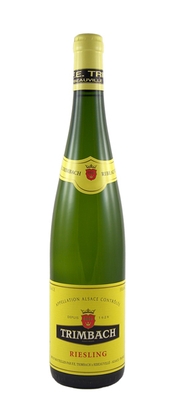|
|
 |

F. E. Trimbach, Alsace (France) Riesling, 2009 (Palm Bay International, $25): If I had to name my top ten wine producers in the world, Trimbach might very well be one of them. I have enjoyed many great Trimbach Rieslings over the years -- not only the exalted Clos Ste. Hune Riesling, one of the world’s greatest white wines, but also  Trimbach’s Cuvée Frederick Emile, a Riesling that seems to defy age. Add to the list the fine Pinot Gris wines from this estate, particularly the Reserve Personnelle, and even the occasional Gewurztraminer. Trimbach’s Cuvée Frederick Emile, a Riesling that seems to defy age. Add to the list the fine Pinot Gris wines from this estate, particularly the Reserve Personnelle, and even the occasional Gewurztraminer.
This fine 2009 Riesling is the basic Riesling wine of Trimbach, and I am reviewing it not only in its own right, but also in recognition of the quality inherent in all of Trimbach’s whites. It comes from what is considered a classic and very good vintage for the Alsace region, marked by warm days and cool nights in September and a harvest of extremely healthy fruit. “Classic” and “Trimbach” are linked concepts in my mind: Trimbach’s wines are dry, as we once knew almost all Alsace wines to be, before the wines became ripe to the point of sweetness. I like the dry style in Alsace.
F. E. Trimbach is a family company that boasts almost 400 years of grape-growing and winemaking history. It is a medium-sized operation by Alsace standards, but its wines have been particularly well distributed in the U.S., and it therefore it has a high profile here. As is the custom in Alsace, Trimbach makes numerous tiers of wine, from its basic line to Reserve and Reserve Personnelle tiers to single-vineyard wines. None of Trimbach’s wines use the Alsace Grand Cru designation, even if the vineyard for a particular wine is recognized as Grand Cru in the AOC regulations. (The establishment of the Grand Cru designation in 1983 met with opposition from a few historic producers such as Trimbach and Hugel.)
This 2009 Riesling seems a particularly fruity rendition, more forthcoming and less minerally-austere than this wine can sometimes be when young. The compelling aroma suggests tart citrus, wet stone and floral perfume. In your mouth, the wine is bone dry and at first seems mouth-filling and soft, until the wine’s high acidity registers in the mid-palate. Flavors of lime, apple and peach are vivid; the wine also has plenty of minerality but for now, those characteristics are lurking along the edges rather than revealing themselves front and center. The wine is crisp but its texture suggests oiliness, lending the wine far more substance than most dry, crisp whites.
When I tasted this wine blind, I actually considered for a split second that it could be contrived, because of its improbable combination of lightness, fullness and pronounced flavor. (It has exceptional balance of the sort that a technically-oriented winemaker would aim to achieve.) I mention this to say that it was, literally, incredibly good.
As delicious as this wine is now, I have no doubt that it can develop nicely in the bottle for three or more years, because Trimbach’s Rieslings are famous for their longevity. For food pairings, I’d opt for a fairly substantial fish dish, poultry, or white pizza.
90 Points
|
 |
|